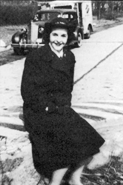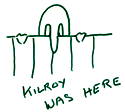The Stamford Historical Society Presents
Pride and Patriotism: Stamford’s Role in World War II
Online Edition
The Interviews
Jane Buckley Jackson
Jane Buckley Jackson joined the WAVES in March of 1942 and went into the service that December. She was in the first class of non-commissioned WAVES and was assigned to the Naval Communications Center in Washington, D.C. where she worked as a cryptographer on the Japanese Codes. She worked in that capacity until 1945.
 I was 18 years old when war broke out in 1941. I had graduated that June from Stamford High and got a job with the telephone company and happened to be working December 7, Sunday in front of this very large board. It was close to three and every light lit up. We were boggled, couldn’t imagine what was going on…everyone was trying to reach relatives and it was then we found out that Pearl Harbor had been bombed. A few months later I heard the government was going to take young women into the Navy and decided that was what I was going to do for a while. I was brought up in a family active in WWII, my mother’s brothers and cousins were all with the fighting 69th, so it was big thing in our family, so I was always enthused about the services. As soon as I heard how to sign up I got into it. I almost didn’t make it because you had to be 5 ft and I just am. You also had to weigh 110 lbs and I wasn’t quite there. I weighed 108, so this delightful sailor said to me “It’s lunchtime, go out and eat as many bananas as you can and I will reweigh you.” and I did exactly that and just made the cut. That was in March ‘42. That December I went into the service. I had my basic training in Iowa, 2-3 month course and then I went to Georgia for additional training then was sent up to Washington to work in communications, which I did for the rest of the time I was in the service. I worked with the Japanese code and I worked with that for quite a while, then they put me into working with the garbled messages which was a little more complex but challenging. I did all of this without knowing any Japanese, which surprises everyone, but their code was done in numbers and I could add from 1-9 so that’s exactly what I did. The day to day work was not terribly exciting until we heard what was happening with the messages that we were passing out that were decoded.
I was 18 years old when war broke out in 1941. I had graduated that June from Stamford High and got a job with the telephone company and happened to be working December 7, Sunday in front of this very large board. It was close to three and every light lit up. We were boggled, couldn’t imagine what was going on…everyone was trying to reach relatives and it was then we found out that Pearl Harbor had been bombed. A few months later I heard the government was going to take young women into the Navy and decided that was what I was going to do for a while. I was brought up in a family active in WWII, my mother’s brothers and cousins were all with the fighting 69th, so it was big thing in our family, so I was always enthused about the services. As soon as I heard how to sign up I got into it. I almost didn’t make it because you had to be 5 ft and I just am. You also had to weigh 110 lbs and I wasn’t quite there. I weighed 108, so this delightful sailor said to me “It’s lunchtime, go out and eat as many bananas as you can and I will reweigh you.” and I did exactly that and just made the cut. That was in March ‘42. That December I went into the service. I had my basic training in Iowa, 2-3 month course and then I went to Georgia for additional training then was sent up to Washington to work in communications, which I did for the rest of the time I was in the service. I worked with the Japanese code and I worked with that for quite a while, then they put me into working with the garbled messages which was a little more complex but challenging. I did all of this without knowing any Japanese, which surprises everyone, but their code was done in numbers and I could add from 1-9 so that’s exactly what I did. The day to day work was not terribly exciting until we heard what was happening with the messages that we were passing out that were decoded.
I had some very interesting experiences. When we went to Washington they weren’t ready for us because this was all put together in a hurry. The barracks were not completed and we were billeted in hotels. Finally, when they were ready for us, I think they were 12 of us when she came to visit the new barracks. I had tea with Eleanor Roosevelt. She was wonderful, if children have not read her biography they should. She to me was the first women’s libber and I listened to her, she was wonderful. She told the 12 of us we could do anything we wanted and nothing should stand in our way. She really inspired me and got me to think about my future and more than that, my ethics, my commitment, she had a tremendous effect on me. She was way ahead of her time. That was one of the highlights really, and I was fortunate enough to be in Washington, when a dear friend of mine was going to Georgetown University studying to be a dentist, so he kept my friends and I in dates, which was a big help. We had fun with that.
I think the other big event, working with the Japanese code, was the day we heard that because the code had been broken, our Air Corps was able to shoot down Admiral Yamamoto. That was the only message that we ever knew about that was decoded and had the effect on the war that that did have. We had a big party after that. Also, being in Washington you were exposed to so much and the advantages. My roommate and I went down to Georgetown University and signed up for college courses and they went out of their way to accommodate us because we were working different shifts, 9-4 and 8-4 around the clock, so they allowed us to take a course with different professors which was wonderful. We were near Catholic University and went over to hear some wonderful speakers. Bishop Sheehan was at that time teaching at Catholic University.
I was in service from 1942 till the end of the war. I loved every minute of it. We thought at one point, and wondered what the sailors would think of us, coming in a relieving them of duty so they could go into battle. Well, they were wonderful. At that time certainly everyone was behind the war. The country was behind the war. There was never any harassment for the women, none. It certainly was a learning experience. The GI bill was also available to us after the war.
Lewis Jackson
 Introduction
Introduction
Veterans
Battles
Stamford Service Rolls
Homefront
Exhibit Photos
Opening Day

